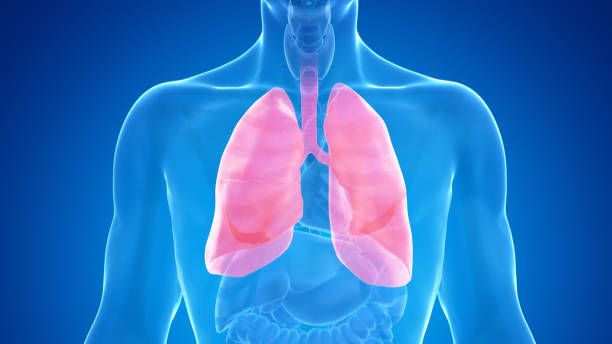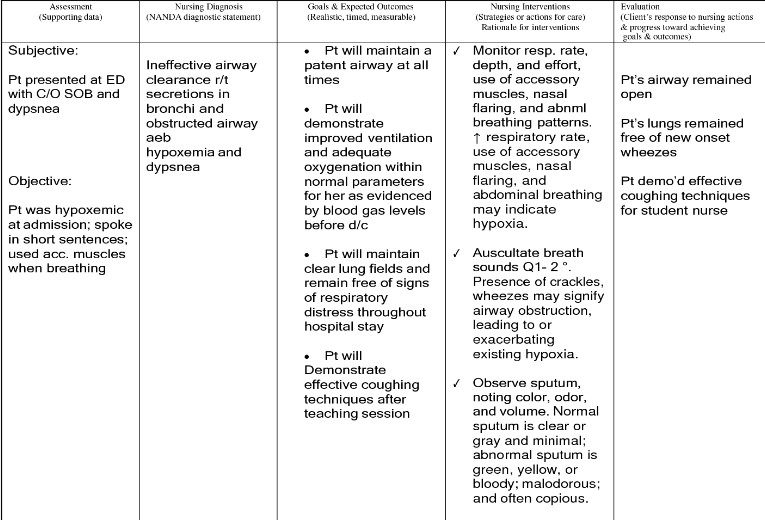A chronic obstructive pulmonary disease (COPD) nursing care plan involves a series of processes to ensure the patient’s well-being. With a proper plan, there could be a significant improvement in a COPD patient’s life. Nursing care plans are crucial in managing COPD patients effectively and improving their outcomes.

Chronic obstructive pulmonary disease (COPD) nursing care plans comprise comprehensive assessment, education, medication management, oxygen therapy, and pulmonary rehabilitation. The main aim is to improve symptoms, prevent exacerbations, and promote self-management. All these actions are done to enhance the patient’s quality of life. Read on to understand more about examples of actions taken in a nursing care plan for activity intolerance related to COPD and such-like symptoms.
RECOMMENDED: Nursing care plans- Ultimate guide and list (updated 2024)
Table of Contents
COPD is a common pulmonary disease characterized by persistent respiratory symptoms such as chronic airway inflammation, which limits airflow. It affects the ability to breathe normally and often results in shortness of breath. It narrows the airways due to inflammation and mucus brought about by inhalation of harmful gases such as smoking. A COPD exacerbation nursing care plan is crucial to prevent further disease worsening.
The nursing care plan for COPD is mainly carried out for patients experiencing exacerbations. Sometimes, the disease is complicated by other pulmonary conditions such as asthma and pneumonia. Therefore, nurses must be vigilant in monitoring the patient’s respiratory status and administering antibiotics and steroids. During nursing, the patient should stay educated on the importance of lifestyle changes such as quitting smoking, increasing activity tolerance, and medication adherence.
It is characterized by reversible inflammation, bronchial smooth muscle constriction, mucus hypersecretion, and edema. Usually, it is caused by allergens, emotional upheaval, cold weather, exercise, chemicals, medications, and viral infections.
Symptoms of chronic bronchitis may include widespread inflammation causing narrowing of the airways and increased production of mucoid sputum.
Emphysema is a severe form of COPD usually characterized by recurrent inflammation that damages and eventually destroys alveolar walls. This creates large air spaces that result in air-trapping.
Chronic exposure to outdoor air pollution, such as car exhaust, industrial emissions, and smog, can increase the risk of developing COPD. Indoor air pollution, especially from biomass fuel used for cooking and heating, also contributes to the development of COPD.
Frequent respiratory infections, especially during childhood, damage the developing lungs and increase the risk of COPD later in life. Also, recurrent disorders in adulthood can accelerate COPD progression.
Long-term exposure to tobacco smoke, whether through active smoking or passive exposure, damages the lungs and increases the risk of developing COPD.
People in industries exposed to dust, chemicals, and fumes are at a higher risk of developing COPD. Occupations such as mining, construction, and agriculture expose workers to harmful substances.
The development of COPD through genetic predisposition is rare. The most common genetic risk factor is Alpha-1 antitrypsin deficiency, which impairs the production of a protective protein that prevents lung damage.
Nursing care plans and management related to chronic obstructive pulmonary disease (COPD)
A nursing care plan for COPD or pneumonia prevents disease progression, reduces hospitalization, and improves overall patient health. An exacerbation is the sudden worsening of COPD, usually characterized by increased shortness of breath, coughing, and mucus production. The nurse should provide oxygen therapy and advise on avoidance of alcohol and tobacco use. Moreover, they should encourage using supplemental oxygen equipment to maintain an average respiratory rate and a stable oxygen saturation level.

A proper COPD nursing plan of care should have the following priorities to ensure minimal exacerbations of the disease:
Maintaining clarity of the airways
Assisting the patient with measures that facilitate gas exchange
Enhancing the necessary nutritional intake
Preventing complications, therefore slowing down the progression of the condition
Providing information about the disease process alongside the treatment regimen.
RECOMMENDED: Politics and the Patient Protection and Affordable Care Act sample essay
Proper patient assessment should be carried out to develop a nursing care plan for acute exacerbation of COPD. It includes looking for specific data, which may include:
Difficulty breathing
Changes in the rate of respiration
Changes in the use of accessory muscles
Abnormal breath sounds, e.g., wheezes, rhonchi, crackles
Persistent cough, often with the production of sputum
Confusion and frequent restlessness
Exertional dyspnea
Shortness of breath
Also, it is essential to check for other factors that may cause COPD, such as:
Increased production of thick, viscous secretions
Hyperplasia of bronchial walls
Decreased bodily energy
Altered oxygen supply due to obstruction of airways by air-trapping
Alveoli destruction or capillary membrane changes
Retained secretions
Ineffective inspiration and expiration due to constraints
A nursing diagnosis for impaired gas exchange related to a COPD nursing care plan may be deemed necessary. While these diagnoses serve as a framework for organizing care, their usefulness may vary. Nonetheless, the nurse’s expertise and judgment will ensure the care plan meets each patient’s unique needs. The nurse should prioritize the patient’s health concerns and priorities.
For effective minimization of flare-ups, some COPD nursing care plan goals may include:
Maintaining clear and patent airways by demonstrating effective breath sounds through the ability to cough and clear secretion
Achieving improved ventilation and optimal tissue oxygenation within the normal range with the absence of respiratory distress symptoms
Demonstration of improved breathing patterns and maintaining a regular respiratory rate
The nurse should assess and monitor respirations, breath sounds, and the inspiration/expiration ratios. Observing for persistent coughing or a moist cough is a common symptom of COPD. Environmental pollution, such as dust and smoke, should be minimal to maintain clear breathing.
For an effective nursing care plan for COPD, the nurse should note the use of accessory muscles and look for pursed-lip breathing or the inability to converse. Monitor changes in the patient’s level of consciousness and mental status and check for characteristics of the sputum produced. Also, evaluating their activity tolerance level and changes in their vital signs and cardiac rhythm is crucial.
As indicated, assessing the patient’s respiratory status is another crucial step in caring for their disease. The nurse should also promote deep breathing exercises such as diaphragmatic, yoga, and pursed-lip breathing. It is critical to monitor for a synchronized respiratory pattern when using a mechanical ventilator and to adjust the ventilator settings as required.
The patient should seek pharmacological support to minimize exacerbations as much as possible. It may include bronchodilators, antimuscarinic drugs, mucolytics, and oral corticosteroids such as prednisone and methylprednisolone.
It involves reviewing the importance of breathing exercises, effective coughing, and adequate fluid intake. Monitoring antibiotic therapy’s effectiveness is also vital to establish what is working for the patient. Furthermore, the nurse should advise and encourage the patient on adequate nutritional intake.

A key objective for any nursing care plan example for COPD is to relieve symptoms and prevent complications. Also, it helps identify the early signs and symptoms in case of an exacerbation or worsening of the disease. The plan provides actionable steps to carry out to manage a flare-up early.
RECOMMENDED: South Dakota Dashboard and Health Care Benchmark Evaluation Essay
A solid COPD nursing care plan involves deep breathing and coughing exercises as part of the pulmonary rehabilitation program. They ensure the care and management of COPD is effective and increase oxygen saturation.
The critical factors checked for in a patient’s assessment for COPD are exposure to risk factors and past and present medical history. Also, if present, the nurse may observe for signs and symptoms of COPD and their severity.
A nurse may insist on the importance of smoking cessation to decrease damage. They may also administer careful oxygen supplementation to reduce inflammation.
Complete ceasing of smoking
Maintaining proper nutrition and exercise
Promoting appropriate levels of rest and exercise
Adhering to the medications administered correctly
Using oxygen supplements appropriately
Retraining the patient’s breathing patterns
Avoiding infections that may further cause complications
Learning techniques to bring up mucus
Creating a self-management plan
Executing pulmonary rehabilitation to reduce dyspnea and fatigue.
Chronic obstructive pulmonary disease (COPD) nursing care plans should involve patient-centered actionable steps focusing on individual needs. By focusing on symptom management, keen observation, and proper education, nurses can significantly improve the quality of life for patients with COPD. These plans address the disease’s medical aspects and encourage patients to actively participate in their care.
Tutorlancers.com recently published a competitiveness and performance effectiveness for health care IT Systems Essay Assignment Paper. Check it out.
Delivering a high-quality product at a reasonable price is not enough anymore.
That’s why we have developed 5 beneficial guarantees that will make your experience with our service enjoyable, easy, and safe.
You have to be 100% sure of the quality of your product to give a money-back guarantee. This describes us perfectly. Make sure that this guarantee is totally transparent.
Read moreEach paper is composed from scratch, according to your instructions. It is then checked by our plagiarism-detection software. There is no gap where plagiarism could squeeze in.
Read moreThanks to our free revisions, there is no way for you to be unsatisfied. We will work on your paper until you are completely happy with the result.
Read moreYour email is safe, as we store it according to international data protection rules. Your bank details are secure, as we use only reliable payment systems.
Read moreBy sending us your money, you buy the service we provide. Check out our terms and conditions if you prefer business talks to be laid out in official language.
Read more